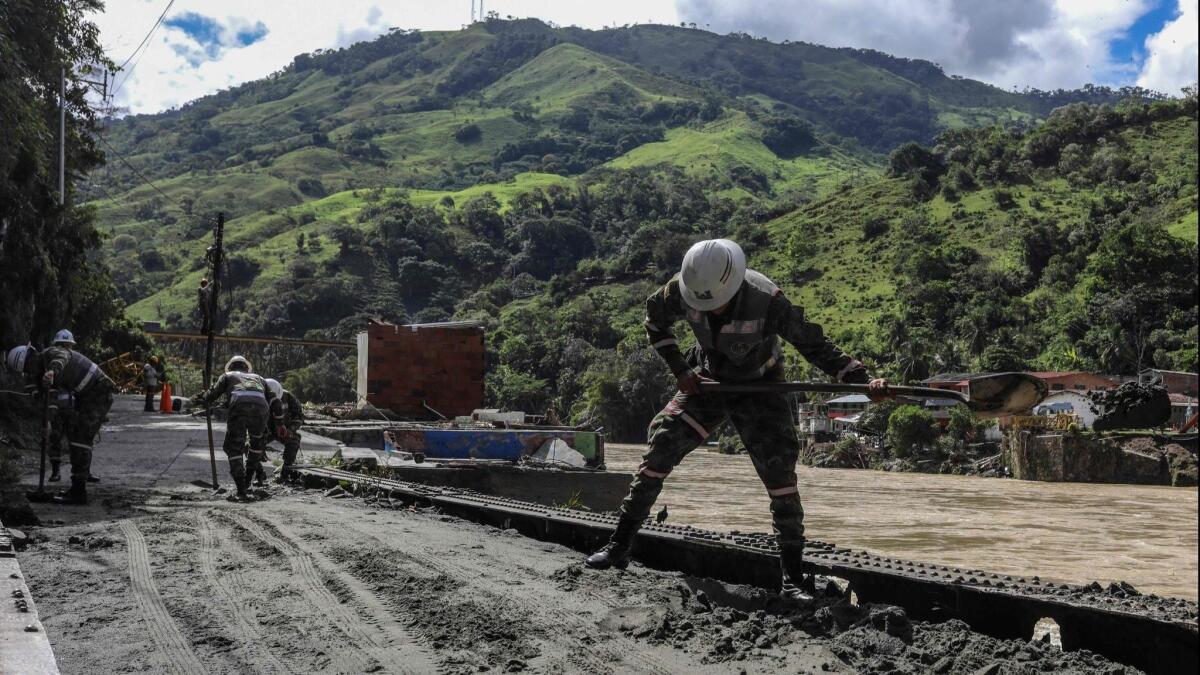2,000 Colombians evacuated, tens of thousands more put on alert amid fears of dam collapse

- Share via
Reporting from BOGOTA, COLOMBIA — After the evacuation of 2,000 residents at risk from floodwaters in northwest Colombia, tens of thousands more were put on alert Friday as engineers struggled to contain the damage at a giant hydroelectric dam project that its owners admitted is in danger of collapse.
The crisis developed at the nearly complete Hidroituango dam site 110 miles north of Medellin after a landslide covered up a tunnel through which waters of the Cauca River were diverted away from construction. The blockage caused water levels to rise prematurely behind the partially built dam, and the water now threatens the structural integrity of the project.
Owner EPM, which is the main electric power utility of Medellin, and local governments rushed Friday to prepare 12 downstream municipalities for possible evacuation should the Hidroituango dam complex show signs of “rupture,” which the utility acknowledged is a possibility. As many as 100,000 people could be affected.
Residents of Puerto Valdivia, located immediately below the construction site, were told to leave last week after a sudden surge of water through a different underground tunnel destroyed two bridges over the Cauca River and several buildings. No fatalities have been reported.
Many of the hundreds of Puerto Valdivia evacuees huddled in a sports stadium 15 miles from the river complained Friday of a lack of food and hygiene facilities and threatened to block a main north-south highway connecting Medellin with the Caribbean coastline.
Protest leaders told El Colombiano newspaper of Medellin on Friday that many families were sleeping on the stadium’s concrete steps.
President Juan Manuel Santos, who returned this week from a European trip to be confronted with the looming dam disaster, was scheduled to visit the Hidroituango project Friday but canceled the trip for logistical reasons, sources said. He is expected to visit at some point this weekend.
Alejandro Lucio, executive director of Colombia’s Renewable Energy Assn., said Friday that it is too early to assess damages to the $5-billion project or to predict if and when the 2,400-megawatt hydroelectric plant, the largest ever built in Colombia, would be brought on line.
“This is very unfortunate. We hope EPM can bring the project back to life, that it can be viable after this,” Lucio said. “But at this point we really don’t know when they will be able to inaugurate it, and it’s irresponsible to try to predict that.”
The project’s first phase was to have gone online by the end of this year, and the second phase by 2020.
Once complete, the project was to have added 17% more capacity to Colombia’s electricity grid.
EPM has called for international assistance in devising measures to control the turbulent river waters that have filled up the dam’s reservoir.
Although EPM blamed a “geologic event” for the landslide that led to the crisis, the Santos government said this week it will insist on an investigation to determine whether human error caused the destructive landslide. Seismic activity is common in the region.
Lucio said the Hidroituango crisis probably means the end of new hydroelectric projects in Colombia, which have been fiercely opposed by environmentalists and local communities. “The environmental and social licensing process is really difficult and time consuming, and after all this happened, [it will be] even more difficult.”
Kraul is a special correspondent.
More to Read
Sign up for Essential California
The most important California stories and recommendations in your inbox every morning.
You may occasionally receive promotional content from the Los Angeles Times.










